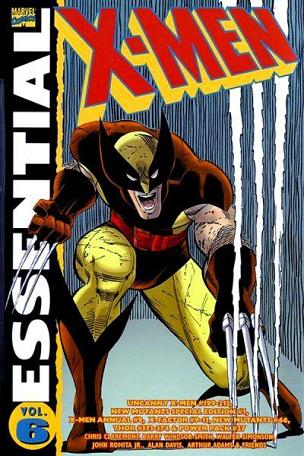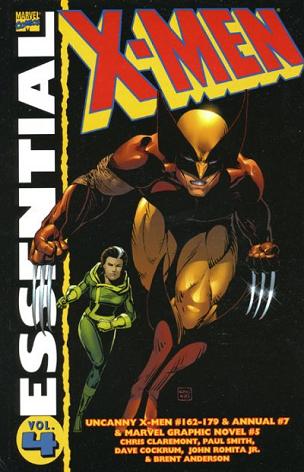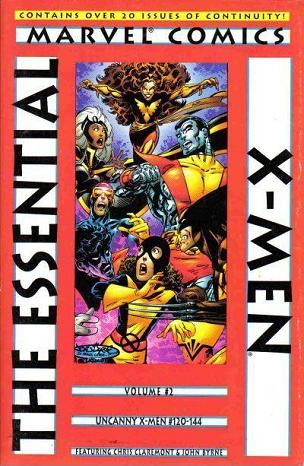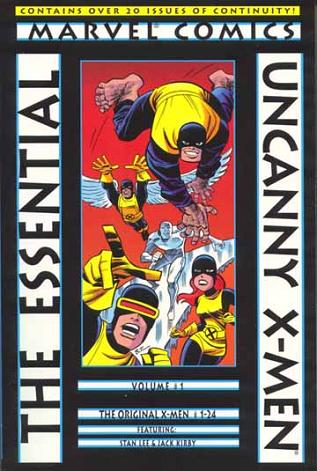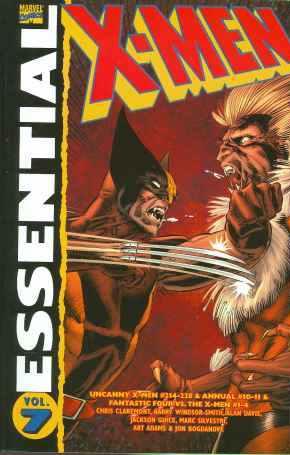
Essential X-Men Vol. 07
Chris Claremont, Marc Silvestri, Jon Bogdanove and friends
Reprints: X-Men #214-228, #Annual 10-11, Fantastic Four v X-Men (February 1987 – April 1988)
Get this for: X-Men at their nadir — three stars
Let’s talk about why the X-Men went sour. Because it did turn sour, didn’t it, at some point in Claremont’s long, long run on Uncanny X-Men. At some point the long drawn out subplots no longer intrigued and mystified, but annoyed, the relentless grinding misery and inability of the X-Men to win their battles started to grind you down as well and the title just seemed to devolve into an endless series of inconclusive battles with ill defined villains. Different people reach this point sooner or later with Claremont, for me rereading some of the stories in this volume it was reached here.
I have to be honest however. Back when I first started following the X-Men, I got going with issue 220, the start of the whole Adversary Saga that was in itself turn of the socalled Fall of Mutants, the big 1988 Summer event in the mutant titles. At the time, dropping in with little real knowledge of the X-Men, I loved this story. Rereading it in context, it now serves as the climax of a long, painful two years of stories in which the X-Men only got more and more hurt. Especially the Fantastic Four vs. the X-Men limited series in retrospect is excruciating in its doom and gloom.
In that miniseries the X-Men call on Reed Richard’s scientific expertise to help save Shadowcat, stuck in phasing mode and slowly disappearing, but he’s uncharacteristic unsure of himself, the result of a longterm psychological trap set by Doctor Doom. Things get worse, the X-Men and Fantastic Four come to blows, Reed’s teammates desert him and Shadowcat’s fate seems sealed… But that psychological trap of Doom’s — a pre-FF journal supposedly written by Reed that shows he planned to turn himself and his friends into the Fantastic Four rather than it being an accident — just doesn’t work for me this time. It’s out of character for the Fantastic Four to believe this so suddenly, or for Reed not to realise it’s a fake straight away. Meanwhile the antagonism between them and the X-Men doesn’t ring true either. For one, Claremont had Johnny Storm use the word “muties”, which just doesn’t fit his character at all. He may be a hothead, but not a bigot.
In the main title, the X-Men are still recovering from the Mutant Massacre and their battles with the Marauders and still in disaster recovery mode. They’re still only reacting to threats, not gaining anything, though slowly trying to rebuild the team. Even then things go wrong, as when they recruit Havok, yet lose his girlfriend, Polaris, to the Marauders. It’s incredibly frustrating to read issue after issue of this sort of halfwins or outright defeats for the X-Men, especially since Claremont is a good enough writer to still make you care for them. That’s the worst part, those glimpses of how good Claremont can be when not obsessed with doom and gloom.
The art in this volume is a mixed bag, with a series of guest artists — Barry Windsor Smith, Alan Davis, Jackson Guice — before The Uncanny X-Men settles with Marc Silvestri, whose very very scratchy, semi-realistic style is quite different from John Romita Jr.’s art in the previous volume, but as good in its own right. So is Jon Bogdanove, on the Fantastic Four vs. the X-Men limited series, who has a more “cute” style. It makes for a less united look to this volume, but then these were never intended to be collected together in the first place…
So yeah, a frustrating, annoying final volume of Essential X-Men to be reviewed in this series. Yet Claremont still manages to hook me here, the bastard.
